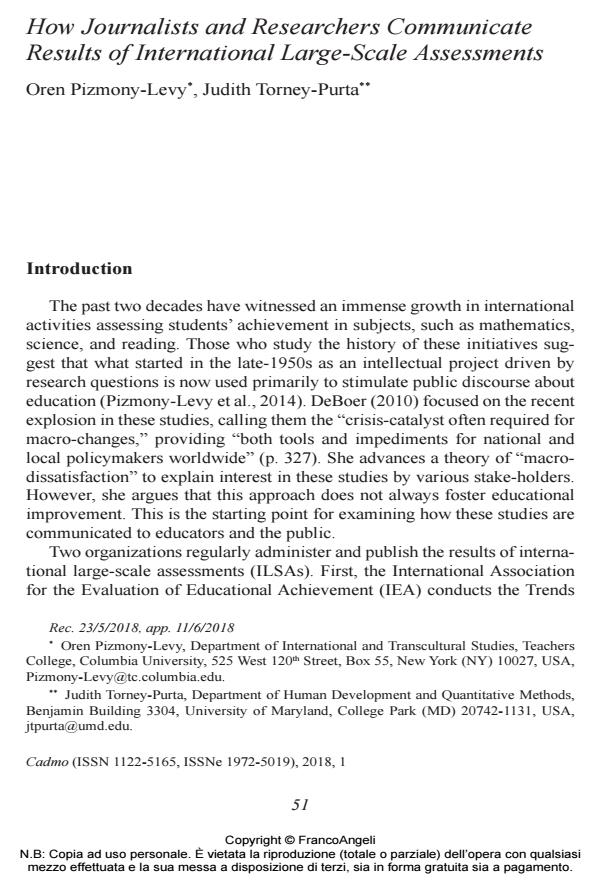How Journalists and Researchers Communicate Results of International Large-Scale Assessments
Journal title CADMO
Author/s Oren Pizmony-Levy, Judith Torney-Purta
Publishing Year 2018 Issue 2018/1
Language English Pages 15 P. 51-65 File size 177 KB
DOI 10.3280/CAD2018-001007
DOI is like a bar code for intellectual property: to have more infomation
click here
Below, you can see the article first page
If you want to buy this article in PDF format, you can do it, following the instructions to buy download credits

FrancoAngeli is member of Publishers International Linking Association, Inc (PILA), a not-for-profit association which run the CrossRef service enabling links to and from online scholarly content.
Organizations conducting international large-scale assessments (ILSAs), such as PISA and TIMSS, rely on the media to disseminate the results. Ex¬amination of the nature of media coverage of ILSAs is limited, however. The paper presents a multi-country analysis of media coverage of OECD-PISA 2012. Using a standardized protocol and samples of news articles from 20 countries, we show how newspapers reduce the complexity of ILSAs into a simple story of international competition. The paper also documents that the findings in subject areas such as the IEA’s civic education studies rarely receive attention from journalists. These studies rely on the initial reports and also on secondary analysis of their data disseminated through channels such as scholarly journal articles. We consider the balance between these approaches as ways to engage the public, educators and education policy makers using the concept of communities of practice.
Keywords: International assessments; education journalists; mathematics education; science education; civic education; IEA; OECD.
- Local meanings of international student assessments: an analysis of media discourses of PISA in China, 2010-2016 Zi Hu, in Compare: A Journal of Comparative and International Education /2022 pp.419
DOI: 10.1080/03057925.2020.1775553 - The Opt-Out Movement and the Reform Agenda in U.S. Schools Oren Pizmony-Levy, Bob Lingard, David Hursh, in Teachers College Record: The Voice of Scholarship in Education /2021 pp.1
DOI: 10.1177/016146812112300501 - The perceived quality, fairness of and corruption in education in Europe Bram Spruyt, Filip Van Droogenbroeck, Leandros Kavadias, in Oxford Review of Education /2024 pp.272
DOI: 10.1080/03054985.2022.2136152 - Differenze di genere e misconcezioni nell'operare con le percentuali: evidenze dalle prove INVALSI Chiara Giberti, in CADMO 2/2019 pp.97
DOI: 10.3280/CAD2018-002007
Oren Pizmony-Levy, Judith Torney-Purta, How Journalists and Researchers Communicate Results of International Large-Scale Assessments in "CADMO" 1/2018, pp 51-65, DOI: 10.3280/CAD2018-001007